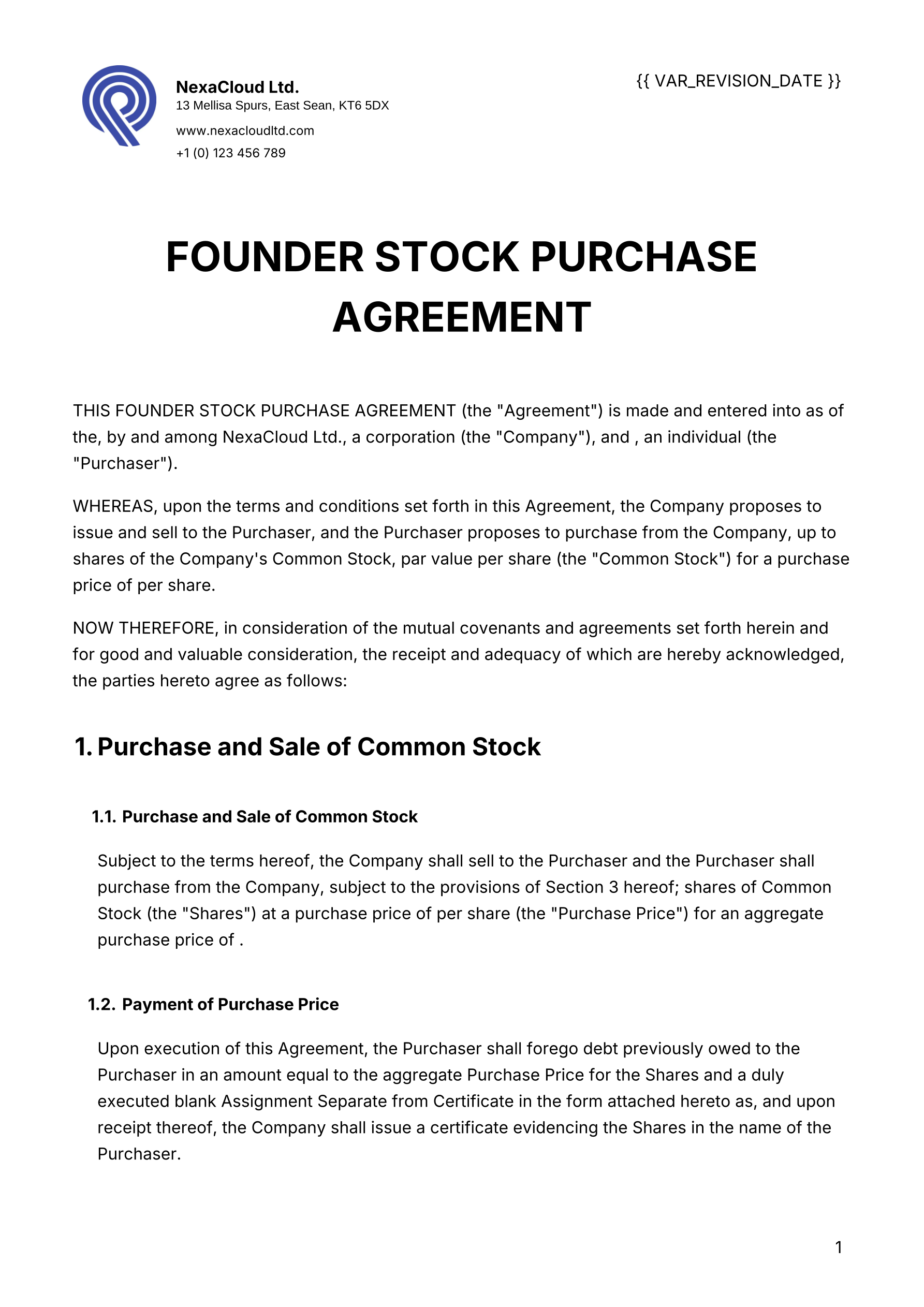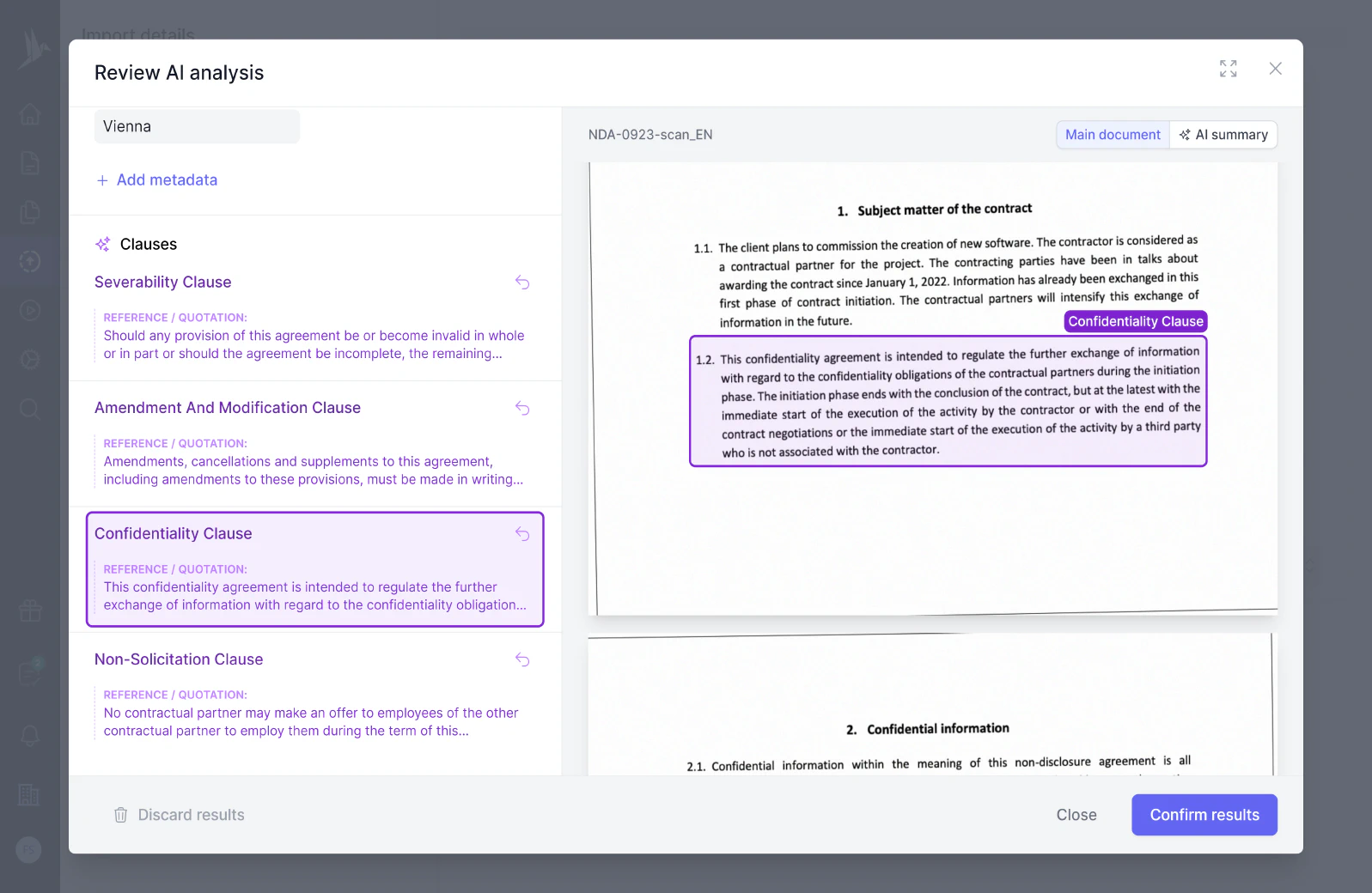
Founder Stock Purchase Agreement Templates & Examples
A Founder Stock Purchase Agreement defines how founders earn and protect their ownership, setting the stage for long-term company success and investor trust.
A vesting schedule is a provision in a contract that determines when and how an individual gains full ownership of certain assets or benefits, such as stock options or retirement plan contributions, over a specified period. Typically used by employers to incentivize long-term commitment, it outlines specific milestones or durations of service required before the individual fully owns the granted assets.
Effective 04/22/2016, Participants who had been previously recognized by the Plan as having had assets transferred to the Plan in conjunction with a Plan merger and having a separate vesting schedule (or schedules) due to such merger or having a vesting schedule in the Plan different from the vesting schedule(s) selected in Section 1.16, will now be 100% vested in all Matching Employer Contributions and Nonelective Employer Contributions in the Plan. The Tecvox OEM Solutions, LLC 401(k) Profit Sharing Plan Nonelective Employer Contributions that merged into the plan will be eligible for the Active Military Distribution (Heart Act)
VESTING SCHEDULE ADDENDUM for Plan Name: Amphenol Corporation Employee Savings/401(k) Plan (a) Different Vesting Schedule Note: With regard to contributions for plan years beginning after December 31, 2006, any schedule provided hereunder must be at least as favorable as one of the schedules in C or D in the table shown in Section 1.16(c).
(1) A vesting schedule different from the vesting schedule selected in Section 1.16 applies to the Participants and contributions described below. (A) The following vesting schedule applies to the class of Participants described in (a)(1)(B) and the contributions described in (a)(1)(C) below: Years of Vesting Service Vested Interest 0 100 (B) The vesting schedule specified in (a)(1)(A) above applies to the following class of Participants: Employees of FCI USA LLC who were participants in the FCI USA LLC Employee 401(k) Savings Plan who merged into this Plan on 10/3/2016. (C) The vesting schedule specified in (a)(1)(A) above applies to the following contributions:
(3) Additional different vesting schedule. (A) The following vesting schedule applies to the class of Participants described in (a)(3)(B) and the contributions described in (a)(3)(C) below: Years of Vesting Service Vested Interest 0 0 1 20 2 40 3 60 4 80 5 100 (B) The vesting schedule specified in (a)(3)(A) above applies to the following class of Participants: Participants in the Amphenol Subsidiaries 401(k) Plan who merged into this Plan effective 11-1-18 who either; 1. terminated from the Amphenol Subsidiaries 401(k) Plan prior to 12-1-05 or 2. terminated in the Amphenol Backplane Systems 401(k) Plan prior to 12-1-05. (C) The vesting schedule specified in (a)(3)(A) above applies to the following contributions:
Note: A schedule elected under E1 or E2 above must be, at each year, at least as favorable as one of the schedules in C or D above. If the vesting schedule is amended, any such amendment must satisfy the requirements of section 16.04 of the Basic Plan Document.
Note: The amendment of the plan to add a Fixed Nonelective Employer Contribution, Discretionary Nonelective Employer Contribution, 401(k) Safe Harbor Nonelective Employer Contribution, Fixed Matching Employer Contribution, Discretionary Matching Employer Contribution, Additional Matching Employer Contribution, or 401(k) Safe Harbor Matching Employer Contribution and an attendant vesting schedule does not constitute an amendment to a vesting schedule under Section 1.16(e) below, unless a contribution source of the same type exists under the Plan on the effective date of such amendment. Any amendment to the vesting schedule of one such contribution source shall not require the amendment of the vesting schedule of any other such contribution source, notwithstanding the fact that one or more Participants may be subject to different vesting schedules for such different contribution sources.
(d) ☒ A vesting schedule or schedules different from the vesting schedule(s) selected above applies to certain Participants. See Eligibility, Service and Vesting Addendum to the Adoption Agreement. (e) If the Plan’s vesting schedule is amended and an Active Participant’s vested interest, as calculated by using the amended vesting schedule, is less in any year than the Active Participant’s vested interest calculated under the Plan’s vesting schedule immediately prior to the amendment, the amended vesting schedule shall apply only to Employees first hired on or after the effective date of the change in vesting schedule. (f) ☒ Other special provisions concerning Vesting Service or forfeitures apply under the Plan. See Eligibility, Service and Vesting Addendum.
(c) Different Vesting Schedule Note: With regard to contributions for Plan Years beginning after December 31, 2006, any schedule provided hereunder must be, at each year, at least as favorable as one of the schedules in C or D in the table shown in Section 1.16(c). In addition, each eligible group defined below must be a definitely determinable group, cannot be subject to the discretion of the Employer, and cannot be designed such that the only Non-Highly Compensated Employees benefiting under the Plan are those with the lowest compensation and/or the shortest periods of service and who may represent the minimum number of such employees necessary to satisfy coverage under Code Section 410(b).
Notwithstanding anything to the contrary in any applicable equity award agreement, (i) all stock options that are subject to a time-based vesting schedule and that are held by the Executive, which would have vested if the Executive had remained employed for an additional [__]1 months following the Termination Date, shall vest and become exercisable effective as of the Termination Date, and all outstanding stock options held by the Executive, including any such stock options that vest in accordance with the foregoing, shall remain exercisable until the earlier of (A) the expiration of the term of such stock options and (B) [__]2 months following the Termination Date, and (ii) [a prorated portion of all other outstanding equity awards (including, without limitation, restricted stock unit awards) that are subject to a time-based vesting schedule and that are held by the Executive shall vest effective as of the Termination Date, representing a total of 12 months of additional vesting, as if each award vested on a monthly basis and without regard to the original vesting schedule (e.g., for purposes of illustration only, to the extent the next scheduled vesting tranche of such an award was an annual cliff, 12/12 of such tranche would vest)]3 [a prorated portion of all other outstanding equity awards (including, without limitation, restricted stock unit awards) that are subject to a time-based vesting schedule and that are held by the Executive shall vest effective as of the Termination Date, representing a total of 6 months of additional vesting, as if each award vested on a monthly basis and without regard to the original vesting schedule.
Time-vesting options are subject to a four-year time-based vesting schedule, with 25% vested on October 5, 2018 and the remainder vesting in 36 equal installments every month thereafter. Represents 24,000 time-vesting options.
“Type I Vesting Schedule” means a Vesting Schedule according to which, 25% of the total number of the Shares comprised in the Option shall vest twelve (12) months after the Commencement Date, and the remaining 75% of the total number of the Shares comprised in the Option shall vest equally on monthly basis over the following thirty-six (36) months;
A vesting schedule is a financial and legal concept commonly used in employment agreements, particularly those involving equity compensation like stock options, restricted stock units (RSUs), or benefits related to retirement plans. It determines the timeline and conditions under which an employee gains full ownership of certain benefits or stock options. Vesting schedules are used to incentivize employees to stay with a company for a longer term and contribute to its success.
You should consider using a vesting schedule in situations where there is a need to encourage loyalty and long-term commitment from employees, founders, or co-founders. It is especially useful in the following scenarios:
Utilizing a vesting schedule helps ensure that contributors earn their shares or benefits over a period as they remain with the organization and fulfill required roles.
Writing a vesting schedule involves outlining the specific terms under which benefits or equity are granted over time. Key elements to include are:
An employee is granted 4,800 shares over a 4-year period with a 1-year cliff and monthly vesting thereafter. After the first year, 1,200 shares (25% of total) vest. Each subsequent month, 100 shares vest.
Vesting schedules are commonly found in the following types of contracts:
These templates contain the clause you just read about.

A Founder Stock Purchase Agreement defines how founders earn and protect their ownership, setting the stage for long-term company success and investor trust.
Dive deeper into the world of clauses and learn more about these other clauses that are used in real contracts.
A "Waiver and Release" clause typically involves a party intentionally relinquishing or abandoning a known right or claim within a contract, often to prevent any future legal action regarding the specified matter. This clause ensures that the party accepting the waiver cannot later pursue claims or seek redress related to the waived rights, providing finality and reducing potential liabilities.
A "waiver of claim" clause is a contractual provision in which a party agrees to relinquish the right to assert certain claims or demands against the other party. This clause helps in reducing potential legal disputes by ensuring that the parties involved cannot later bring up the waived claims in legal proceedings.
A waiver of confidentiality clause allows parties to a contract to agree that certain confidential information can be disclosed under specified conditions, effectively lifting the obligation of confidentiality. This clause typically outlines the scope, purpose, and potential limitations of such disclosures to ensure mutual understanding and consent.
Try our AI contract analysis and extract important clauses and information from existing contracts.
< <
Fill out the form and we will get in touch with you to give you a personal, customized demo of fynk.
Greetings!
I'm Markus, co-founder of fynk. After you've submitted the form, I'll swiftly get in touch with you.
Also, right after you submit your details, you can pick a time that works best for you for our meeting.

